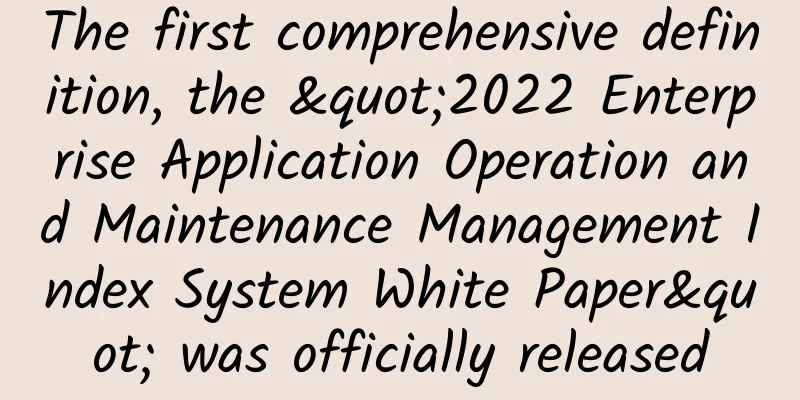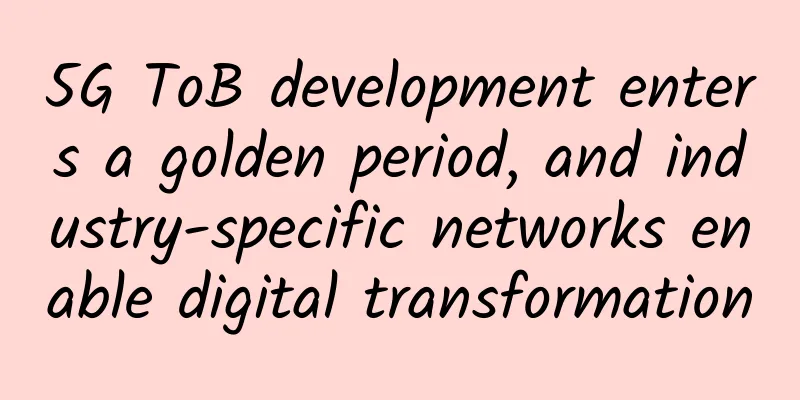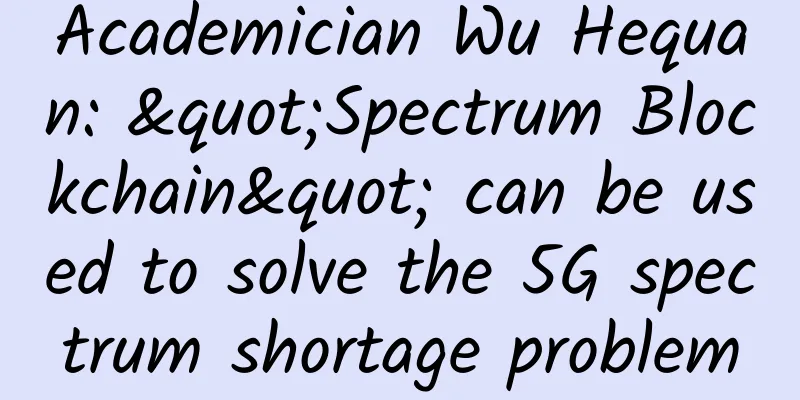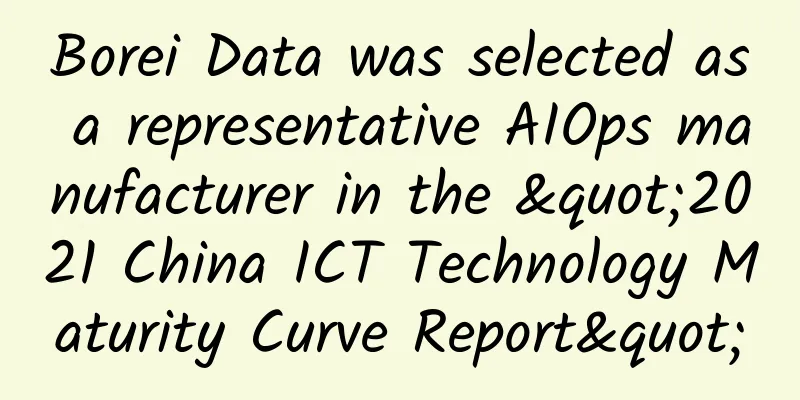The first comprehensive definition, the "2022 Enterprise Application Operation and Maintenance Management Index System White Paper" was officially released

|
Recently, Borei Data and iResearch jointly released the " 2022 Enterprise Application Operation and Maintenance Management Index System White Paper" (hereinafter referred to as the "White Paper"). The "White Paper" explains in detail the connotation of enterprise IT operation and maintenance and the changes and problems faced by enterprise IT operation and maintenance in technology, strategy, organizational structure, etc. in the current environment of digital economic development. It also demonstrates an enterprise application operation and maintenance management index system based on business and applications, and explains in detail the principles, design and practice of the system. The Importance of Enterprise Application Operation and Maintenance Management Index System The White Paper points out that as Internet services penetrate into thousands of industries, digital applications have become an important form of service for enterprises and institutions to provide services to users. Direct monitoring and optimization of the user experience link has become a new idea and approach for IT operation and maintenance. Compared with the traditional operation and maintenance for enterprise IT resources, the IT operation and maintenance method for user experience focuses more on the front-end business side and can improve the performance of various services in a more obvious way. With the development of the Internet economy, this operation and maintenance idea has been fully implemented in enterprises. In addition, in the digital age, the operation and maintenance system of enterprises needs to shift to the application-side perspective, and enterprises need a new operation and maintenance system. As mentioned in the "White Paper" about the operation and maintenance status, problems and development plans of a leading listed city commercial bank in China, it can be seen that to adapt to the above-mentioned changes in infrastructure and business forms, enterprises need systematic methodological guidance and a clear indicator system. At the same time, with the development of the digital economy and the continuous increase in the social and economic value it creates, China's IT talent costs continue to rise under the stimulation of market demand. The increase in IT talent costs has a direct impact on enterprises, which is the increase in the cost of hiring employees, including operation and maintenance. For enterprises, reducing dependence on manpower and experience is an effective way to deal with the above problems. In order to achieve this goal, enterprises need to build systematic indicators, processes and organizational collaboration systems for operation and maintenance work. Therefore, in order to give full play to the strategic value of enterprise operation and maintenance, enterprises need to open up the communication channels between the operation and maintenance department and other departments from top to bottom, form a joint force, and jointly empower the digital transformation and upgrading of enterprises. In order to better empower business innovation, the operation and maintenance department not only needs to iterate the operation and maintenance technology, but also needs to establish a more complete operation and maintenance indicator system that can continuously empower and iterate, to clear the channels of communication with business departments and management, so that the operation and maintenance department can give full play to its technical advantages and innovation capabilities, enhance the value that operation and maintenance work brings to the enterprise, and increase the input-output ratio of operation and maintenance work. From the above, it is not difficult to see that enterprise IT operation and maintenance is undergoing a transformation from "backstage" to "middle stage", and needs to further exert its effect of "reducing costs and increasing efficiency" in enterprises. Therefore, in order to improve the input-output ratio of operation and maintenance and enhance the value creation attribute of the operation and maintenance side to the business side, the operation and maintenance department of the enterprise needs to build a set of operation and maintenance management indicator system, which will help the enterprise operation and maintenance department to form an efficient workflow system, improve the efficiency of daily operation and maintenance work, reduce the dependence of operation and maintenance work on manpower and experience, and provide support and guidance for the deployment of intelligent operation and maintenance applications based on big data. The first comprehensive definition of enterprise application operation and maintenance indicator system Taking Borei Data's enterprise application operation and maintenance indicator system as an example, this system is based on a business perspective, with business scenarios as the theme and business continuity as the purpose. By directly facing business scenarios, forward combing IT call chains, and reversely accessing data sources, it ultimately builds a resource indicator management system that has the ability to overview the health of all business scenarios and overlook multi-dimensional and three-dimensional IT indicators. Specifically, it is divided into the following 7 aspects: 1. Business end The business side is the primary focus of the enterprise application operation and maintenance indicator system. For enterprises, business conditions are the most concerned part of enterprise managers and the basis of all enterprise decisions. With the development of big data and artificial intelligence technology, a large number of enterprises have achieved transformation and upgrading with the help of information technology. Business data indicators can provide data insights for business-side employees and managers. When employees and managers make decisions, they no longer just " shoot their heads " based on experience, but make strategic adjustments and decision-making plans based on the results of data analysis. 2. User side The user end ( APP , mini-programs, websites, etc.) is the digital touchpoint between enterprises and users, and is also an important way for enterprises to acquire and retain customers. In the entire chain of Internet / digital services, customers need to pay primary attention to the user end experience and performance, making the user end experience an important part of the product strength and market competitiveness of enterprises in digital operations. The user end operation and maintenance quality with the core of improving experience will directly affect the user's impression and evaluation of the enterprise, and is a good focus for enterprises to carry out operation and maintenance work. 3. Application side The access situation reflected by the user-side indicators is only a superficial phenomenon. What the user actually accesses is actually the backend application of the website. Currently, enterprises are facing the increasing IT complexity and rapid changes in business needs. The possibility of IT applications experiencing performance degradation or service unavailability during operation has greatly increased, thus affecting the normal operation of business services. Application monitoring can not only help enterprises quickly locate problems and save costs, assist enterprises to continuously pay attention to the application performance status and obtain real-time feedback, but also help enterprises deploy applications in containers. 4. Network monitoring The calls between applications are realized through the network. The scale and complexity of IT construction in various enterprises are increasing day by day. It is necessary to optimize the existing operation and maintenance processes through network monitoring to continuously improve the management and operation and maintenance level. Network facilities connect the IT basic resources of the enterprise and the user experience of the end. They can also reflect the number of customers, business traffic, business time, region and other characteristics of the enterprise. In special scenarios, they also involve data security and other issues. They can help improve the innovation and product strength of the enterprise's digital services to a great extent. 5. Resource layer monitoring All website services are reflected at the basic resource level. Therefore, basic resource monitoring is the most basic part of all monitoring and is an indispensable part of realizing AIOps . 6. Middleware monitoring With the rapid development of computer technology, more application software needs to run in a variety of network protocols, hardware and network platform environments. This has led to software developers facing problems such as data dispersion, operational difficulties, and low system matching. They need to develop multiple applications to achieve management and operation. The development of middleware technology has greatly reduced the burden on developers and made the network run more efficiently. 7. Database In an environment where data has become an important operating asset for enterprises, efficient operation and maintenance of core databases can help enterprises maintain system problems and information security from the bottom of the data. At the same time, with the continuous penetration of new database construction models such as lake-warehouse integration, database operation and maintenance will also face challenges and innovations, requiring enterprises to pay more attention. Four steps to build an application operation and maintenance management indicator system This time, the "White Paper" jointly released by Borei Data and iResearch Consulting not only provides a reference for the writing of the "White Paper"; at the same time, the "White Paper" is also an important guide for Borei Data's future work. Only by introducing more comprehensive and higher-demand indicator specifications can the company's products be guided towards a more stable and higher-quality direction, thereby shaping an industry application benchmark. In Borei Data's view, the construction of an enterprise application operation and maintenance management indicator system needs to start from four steps: comprehensive business review - determining key application actions - pre-defining key indicators - and implementing an enterprise application operation and maintenance management platform. 1. Comprehensive business review In the Internet business environment, there are many sources of users, including paid advertising, search, content social networking, offline promotion, etc. Then users will enter the APP , public account, mini program or website to visit the company's homepage and register, browse products, add to cart, pay, etc. User journeys are diverse, and companies need to sort out user journeys for different businesses. 2. Determine the key actions of the application When enterprises are looking through their business and monitoring their IT architecture in conjunction with their business, it is important to identify key actions in the entire business process, such as user behaviors such as registration, login, and payment, and the specific services, interfaces, microservices, or databases involved and other related resources. 3. Predefine key indicators Different businesses have different characteristics, and the key links in the business processes are different. Enterprises need to sort out indicators from the business, application, service, and hardware levels based on the key behavioral actions of different businesses, so as to plan an application operation and maintenance management indicator system that meets the characteristics of different businesses. 4. Enterprise Application Operation and Maintenance Management Platform Finally, in the process of implementing the enterprise application operation and maintenance management platform, the enterprise application operation and maintenance management platform is needed to provide strong support. Taking Borei Data as an example, the platform needs to have the ability to access data such as APM , Log , business, basic equipment, CMDB , etc., and be able to combine previous successful industry construction experience, industry development and other knowledge to form a dynamic update system platform covering the entire chain of "business combing - key application confirmation - core indicator combing - indicator health classification - indicator update", providing comprehensive support for the company's own resource utilization, business monitoring, decision support, intelligent operation and maintenance and other scenarios. In addition, enterprises will use a variety of monitoring products in the process of building an indicator system, which requires enterprises to pay attention to the stability and maturity of each product. Borei Data believes that two important indicators can be paid attention to: CMMI5 and China Academy of Information and Communications Technology's intelligent operation and maintenance maturity assessment certification. Zhang Chong, senior architect director of Borei Data, said: "For enterprises to truly achieve the transformation from ' O perspective ( Operation )' to ' C perspective ( Customer )', they need to build a new application operation and maintenance indicator system. The system construction process needs to go through several key processes such as business combing, key action determination, key indicator definition, and platform construction. At the same time, it needs to be pointed out that the indicator system needs to be dynamically adjusted according to the continuous development of the business to ensure the stability, observability and traceability of the indicator system." iResearch believes that building an application operation and maintenance management indicator system will help enterprise operation and maintenance departments form an efficient workflow system, improve the efficiency of daily operation and maintenance work, reduce the dependence of operation and maintenance work on manpower and experience, and provide support and guidance for the deployment of intelligent operation and maintenance applications based on big data. Attached is the full download link of the white paper: https://www.bonree.com/bonree/pdf/WhitePaper.pdf |
>>: Wi-Fi Alliance: Wi-Fi 6 and 6E have been "rapidly adopted"
Recommend
Is 5G really going to kill WiFi?
If we were to say what surrounds our lives nowada...
CUBECLOUD New Year promotion cloud server 25% off, Los Angeles CN2 GIA/Hong Kong CN2 GIA route optional
CUBECLOUD has launched a limited-time promotion d...
Research And Markets: Global Computer Vision Market Size to Reach $95 Billion in 2027
On March 24, according to the latest report relea...
Tencent Cloud Light 1C2G3M annual payment 83 yuan, Hong Kong Light 1C1G30M annual payment 298 yuan, new and old users are welcome
Tencent Cloud's Double Eleven event is still ...
5G and Wi-Fi 6, the next generation of infrastructure?
Cellular and Wi-Fi networks have come together to...
Shumai Technology offers a limited-time 45% discount, with monthly payment starting from 300 yuan for Hong Kong independent servers
Shumai Technology is a business that mainly provi...
In the 5G era, how do the three major operators fight the edge war?
5G makes the Internet of Everything possible. Whi...
Hostodo: $19.99/year KVM-1GB/12GB/4TB/Las Vegas
Hostodo has released several promotional packages...
Operators’ deployment of the Metaverse: a good business that will not lose money whether you win or lose
[[437233]] Recently, the hottest word is naturall...
5G will accelerate the development of smart grids by filling three major shortcomings
The importance of electricity to human beings is ...
The 2G era will not come to an abrupt end; network transformation requires the support of the Internet of Things
Recently, China Unicom announced that it will car...
AI identification and root cause location of 5G wireless problems help improve network quality
Author: Zhang Zhe and Chen Juanjuan, unit: Hebei ...
5G development is timely and network construction should be moderately advanced
At present, the overall development of 5G in the ...
WeChat's strongest rival! The three major operators have begun to deploy 5G messaging on a large scale
[[358302]] 5G messaging, which is seen by the ind...
[Black Friday] CMIVPS: 50% off on all VPS annual payments, 30% off on top-up
CMIVPS has launched its last big promotion this y...









